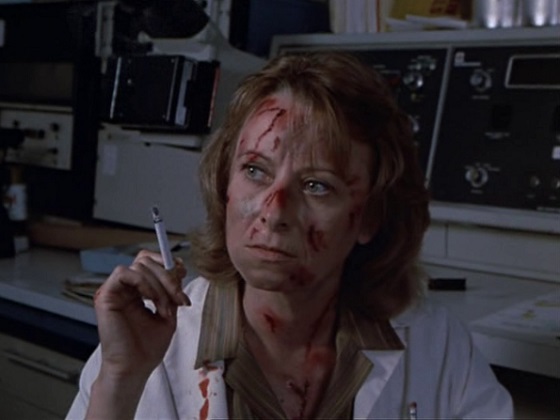This week’s Cinema Fearité is going to be a little different. With Donald Trump sending warships to North Korea and their leader, Kim Jung-un, constantly developing and testing his country’s nuclear capabilities, the world hasn’t been this close to nuclear war since the Reagan era more than thirty years ago. It’s time to revisit the 1983 television movie The Day After.

Set in Midwestern America (specifically Lawrence, Kansas, and Kansas City, Missouri), The Day After chronicles the events leading up to a huge Soviet nuclear strike, the actual attack itself, and the aftermath of the devastation. The film begins as just another lovely day in Kansas, but with the threat of nuclear war between the USA and the USSR always hovering in the background via news reports on nearby television sets or ever-present radios. When the citizens of the town see missiles launch from the nearby Air Force base, they are left to wonder whether the US has struck first, or if they are seeing the retaliation for an attack that is already on its way. Either way, they know they’re in trouble.

The attack comes at about the midpoint of the movie, with the second half depicting the nuclear holocaust that follows. The lucky survivors stumble through the rubble, fight with squatters and looters, and suffer radiation poisoning as they try to figure out what to do with their lives now that the world has so drastically changed. The important things from before the attack, like symphony tickets or wedding plans, don’t seem so important when civilization lies in shambles all around them.

The Day After was directed by Nicholas Meyer (Time After Time, Star Trek II: The Wrath of Khan) from a script written by Edward Hume (The Terry Fox Story, John and Yoko: A Love Story). Although it is definitely a television movie, with a big-time cast that includes talent like Jason Robards (Something Wicked This Way Comes), JoBeth Williams (Poltergeist), Steve Guttenberg (the Police Academy movies), John Lithgow (Twilight Zone: The Movie), and Amy Madigan (The Dark Half), it’s also very exploitative. But the exploitation is purposeful; it was meant to scare, and that’s what it did.

For its original broadcast on the ABC network in November of 1983, The Day After opened with a title card that warned viewers that what they are about to see could be considered disturbing. Children were, however, encouraged to watch with their parents, and 1-800 hotlines were set up so that any viewers with questions or issues could talk to trained counselors. After the movie, ABC aired a live debate hosted by newsman Ted Koppel in which scientist Carl Sagan argued against nuclear weapons while political commentator William F. Buckley Jr. defended them. Sagan seemed to win the debate with an analogy: “Imagine a room awash in gasoline, and there are two implacable enemies in that room. One of them has nine thousand matches, the other has seven thousand matches, and each of them is concerned about who’s ahead.”

Whether all of the cautioning was sensationalized or not, it worked. Almost one hundred million viewers tuned into The Day After, and all of them were faced with the philosophical questions posed by the film. At one point in the first half of the movie, a man in a barbershop posits “how do they expect it’s gonna stop with just one bomb?” Once the missiles are on their way, the soldiers at the Kansas City air force base in the film make the observation that “the war is over!” with the initial launch, noting the intense devastation that is bound to come next. And, while the film shows only what is happening in America, the characters receive word that the Soviet Union has sustained equal damage, so what was the point of the short little war besides eradicating everything? The Day After was quite a lesson in Reagan-era nuclear brinkmanship, but it probably wasn’t the one that the politicians wanted to teach.

The most terrifying, and therefore, the most traumatizing, scene in The Day After is the nuclear attack scene itself. The scene uses actual nuclear weaponry test footage obtained from the US government that illustrates the powerful destruction that is caused by an atomic bomb blast, with buildings being levelled and trees blowing horizontally until they’re uprooted. There are eerie visual compositing effects spliced in as well that speculate what would happen to a human body when it is that close to a detonation site (hint – it involves glowing vaporization). As the military would not authorize the use of any actual atomic mushroom cloud footage, the nuclear explosion plumes in the film were created artificially by squirting colored oil into a water tank, which explains why the backgrounds during the blast look like lo-tech rotoscoping. Even with the primitive visual effects, the nuclear attack scene in The Day After is probably the most harrowing six minutes of television ever broadcast, at least up until that point.

The Day After concludes with an ominous message that says “The catastrophic events you have just witnessed are, in all likelihood, less severe than the destruction that would actually occur in the event of a full nuclear strike against the United States.” This is not encouraging to the audience after the dystopian nightmare that they have just witnessed. The rumor mill claims that The Day After affected President Ronald Reagan so profusely that he re-thought his own stance on nuclear weapons. Hopefully, someone will show The Day After to Donald Trump and Kim Jung-un so that today it can be read as a warning sign instead of as a survival manual.

If you made it this far, thanks for bearing with this special edition of Cinema Fearité. Next week, we promise we’ll be back with more spooky ghosts and masked murderers.